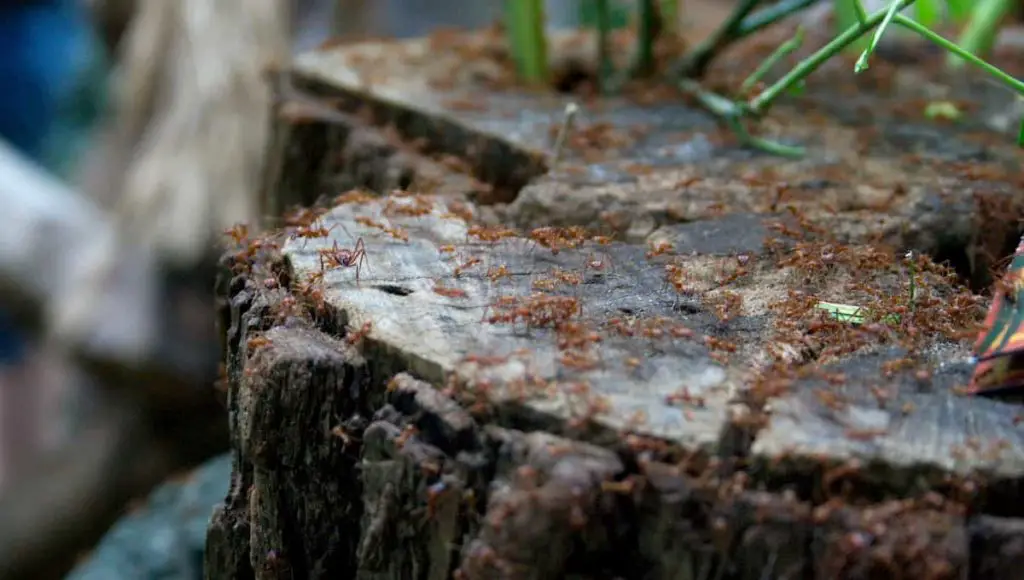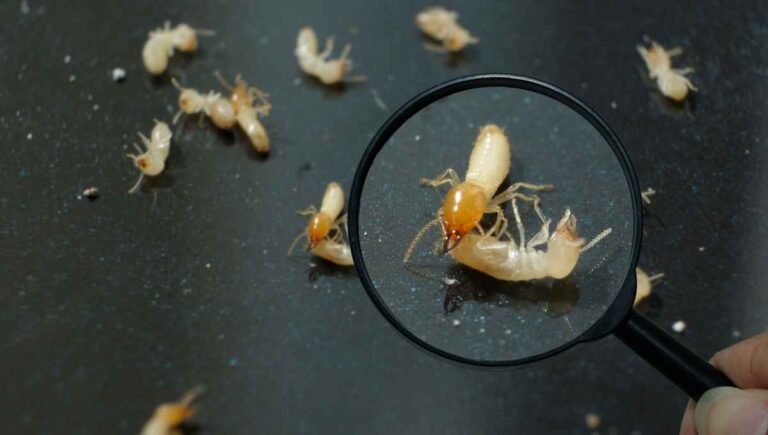How To Deal With Termites In Firewood

Silent assassins or destroyers and tiny wood killers – these are some of the names for which we refer to termites. Learning how to deal with termites in firewood is imperative, because while harmless insects on their own, colonies of these pests that run into the hundreds can wreak absolute havoc.
Many people stockpile firewood in preparation for colder weather, but with this comes the dangers of attracting termites that feed off any wood, including firewood. None is immune to the feeding frenzy of these insects, so you must identify termites before bringing logs into your home.
Read on to learn more about these destructive pests, which includes learning the signs of termites in firewood, how to get rid of termites, and the ways in which you can prevent an invasion and finding termites in firewood piles.
This post contains affiliate links from Amazon and other stores. This means Yard Blogger may earn a commission if you make a purchase using any of our links. Please refer to our full affiliate disclosure policy for full details.
Here’s a Quick Pro Tip!
If you are serious about getting rid of termites in your firewood quickly, then you need to grab a few bottles of BoraCare on Amazon.
Out of all the options for dealing with termites in firewood, BoraCore was praised as one of the only things that seemed to consistently work when the others didn’t.
BoraCare seriously works wonders and gets rid of infestations in a matter of days.
- Why Do I See Termites in Woodpiles?
- The Types of Termites Found in Firewood
- What Do Termites in My Firewood Typically Look Like?
- Signs of Termites in Firewood
- Finding Termites in Cut Firewood
- When Can Termite Infestations Affect the Home?
- Tips for Preventing Termites in Firewood
- Signs That Your Termite Infestation Has Spread
- How to Kill Termites in Wood
- Chemicals That Kill Termites
- What Inexpensive Products Can I Buy Online and From Home Depot Stores?
- When to Call in the Professionals
- Other Professional Treatments Include:
- How Not to Kill Termites in Wood
- Recap: What to Do With Termite-infested Wood
Why Do I See Termites in Woodpiles?
Termites feed on cellulose, which are nutrients that are found in wood. These hated pests are also found where there’s moisture. So if for whatever reason, your wood is damp, you may soon have a termite problem on your hands.
Termites may love the taste of wood, but because they need moisture to survive, they can’t reach wood if they don’t have access to the soil. If you’ve positioned your wood in stacks on the ground, you’re practically inviting termite colonies to a buffet – we’ll touch on how to store firewood to avoid termites later.
The Types of Termites Found in Firewood
There are two types of termites found in America, one that’s more common than the other.
The subterranean species are widespread household pests. While a termite colony of this kind isn’t dangerous to humans, an uncontained invasion can cause extensive damage to your home.
You’ll know that a subterranean colony is at large if you see mud tunnels near or inside your firewood. These tunnels, which are dug underground, can span 150-feet from the colony to the food source.
These insects are tiny invaders that can eat rapidly through wood, leaving few traces of their invasion, until it’s too late. Typically, while subterranean termites are wood-munchers, they’re more attracted to wood that’s connected to the soil, which is why it’s so important to keep it out of the way.
On the other hand, dry wood termites in firewood is another issue entirely because these termite species get all the nutrition they need from wood and don’t require soil for moisture.
While known to consume wooden household structures, such as frames, floors, and furniture, no type of wood is invulnerable from a possible attack.
If you live in the southeastern regions of America, such as California, Arizona, New Mexico, Texas, Louisiana, Mississippi, Alabama, Georgia, and Florida, be sure to store your wood away from walls. Otherwise, dry wood termites can enter your home through the smallest cracks in the walls, digging their way through whatever surface in search of wood.
What Do Termites in My Firewood Typically Look Like?

is licensed under CC BY-SA 2.0
Have you looked up pictures of termites in firewood on Google? They’re not the prettiest creatures.
Colonies of termites can be classified into four castes, including the queen, soldiers, workers, and swarmers.
As the queen produces babies, she is giant compared to the rest of her colony, resembling that of a garden slug. You may see her if you uncover a termite mound.
Work termites are more commonly seen and can be identified by their pale, featureless shape. From far, they resemble maggots. However, at close range, you’ll see that they have an antenna and six legs.
Aptly named, the soldier termites protect the nest against predators and enemies. It’s distinguishing features include full-bodied yellow coloring and brown pincers.
The swarmers are commonly mistaken for flying ants due to their four large wings on their backs, which are twice the size of their tiny bodies.
Their coloring varies between brown and black. If you see these termites fluttering about, it’s a sure sign that the colony has matured within your firewood, and if you’re unlucky, in the structures of your home.
Aside from being misidentified with various other critters, termites are mistaken for ants, which can be problematic because termites cause significantly more damage than a colony of ants. Below we’ve listed the principal differences between the two insects.
Coloring
While the coloring of the different sub-species of termites varies, they are, on the whole, lighter than ants. Remember, that ‘white ants’ don’t exist, so if you spot one with strange, pale coloring, you’ve likely spotted a termite instead.
Antenna
Do the insects you’re looking at have straight antennas? You might be encountering a termite colony because, on closer inspection of ants, you’ll see that they have bent antenna.
Abdomen
Ants have a narrow abdomen, while termites are thicker around the middle.
Wings
Both flying ants and swarmer have the same number of wings. However, the wings of flying ants are different sizes, where the one pair is smaller than the other. With swarmer termites, both sets are the same.
Signs of Termites in Firewood
How Can You Tell If There Are Termites In Your Firewood?
Often, it’s challenging to identify a termite infestation because, as it’s been mentioned previously, termites work quickly and silently. Therefore, you may only know you’ve got a problem on your hands when it’s advanced.
That said, there are telltale signs that you can look out for, which include:
Damaged Wood
Knock on a piece of wood. Termites eat from the inside-out, so if the firewood sounds hollow, the chances are that these insects are in the vicinity.
Rotten wood is also telling that termites have done their rounds through your pile of firewood.
Mud Tubes
As we’ve mentioned, subterranean termites devise mud tubes that connect their colony to their food sources, typically wood structures.
These mud tubes can be easily recognizable, found in the cracks of your wood, and also on the nearby ground. First, examine the wood piece, then take a look around for mud tubes, remembering that these constructions can span several feet.
Opening the piece of wood for a closer inspection will give you a clearer indication as to whether termites are around. Seeing burrows isn’t necessarily a sign that there are termites because any number of insects could make those marks, including beetles and ants.
However, the presence of termites is higher if you find mud in your firewood.
Flying Termites (Termite Swarmers)

Swarmers or aletes are termites that leave the nest in search of a mate to form a new colony. Seeing these creatures may tell you that it’s too late to try and contain your invasion and that professional assistance may be required.
During late spring and early summer, you may also find scattered wings of swarmers lying on the ground, which is yet another sign of termites living in on your property.
Frass
Frass is what termites leave behind during tunneling and eating wood. It’s fecal matter that’s often mistaken for wood shavings due to its fine and powdery texture.
Clicking Sounds
Termites may be silent workers, but they’re loud eaters! Place your ear near to your firewood, and if you hear a distinct clicking sound, know that these are worker termites happily munching away.
Interestingly, soldier termites also make noises by banging their heads against wood or vibrating their bodies, warning others that the colony is being threatened.
Finding Termites in Cut Firewood
People are often warned that bringing termite-infested firewood into the house results in rapid spreading, to the point where the entire structural integrity of your home is threatened.
While there is some truth in the above statement, there are a few things that you should know before you rush to disinfect your home.
There isn’t much danger to finding termites in firewood that you’ve recently bought or chopped down. These pests can’t survive without their colony and queen, which are located underground, and without enough moisture, they will surely desiccate and die naturally.
Can you still burn or use wood that has termites, though? Err on the side of caution by not burning the wood inside, but instead, make a bonfire and burn the wood in your yard, making sure to check with the local ordinance before doing so. You’ll also find that termites in woodpiles result in damaged pieces of wood that don’t burn well, so using them in your fireplace to bring warmth is pointless.
When Can Termite Infestations Affect the Home?
Using Old Wood
Bringing termite-infested wood into the house becomes problematic when the wood you’re using is old, having sat, unused, in your log piles for a couple of seasons. This firewood may be damp or waterlogged by rainfall or snow. If you believe your wood to be passed its expiry date, it’s better to dispose of it.
Stacking Your Wood Against Your House Or Other Building
People are advised against stacking their wood in piles on the ground. However, elevating your firewood, only to rest it against the wall of your home, could also bring on the onslaught of unwanted termites and result in your home’s foundation being compromised.
Not Elevating Your Wood
This point can’t be emphasized enough. The chances of finding termites in your firewood are near guaranteed if you store it in piles on the ground.
Storing Firewood Indoors
People love bringing firewood into their homes, stacking it near to their fireplaces because it sets the scene for winter, can look quite pretty and beats having to fetch wood from your yard when it’s freezing outside.
That said, wood comes from nature and is the source of food and shelter for a trifecta of bugs, including the dreaded termite.
If you have an infested wood bundle, you could accidentally instigate a home invasion, especially if your pile is stacked against a wall.
Feeling cold pales in comparison to replacing the termite-damaged property that could cost you millions of dollars to repair. Keep your firewood outside, approximately five-feet away from entryways to your home, and only bring in wood if you plan on burning it straightaway.
Tips for Preventing Termites in Firewood
Chop Your Wood Into Smaller Fragments
Moist and dark areas are breeding grounds for a variety of pests, including termites. If your wood is wet or damp, it’s a good idea to chop it up into smaller pieces to help the wood dry quicker.
When stacking, leave spaces between the wood to keep it dry and to prevent moisture from accumulating.
Throw Away Damp Wood
If your wood is damp and can’t it dry properly, it’s better to throw it away than try to use it. Various bugs thrive and breed under moist, dank, and dark areas.
Firewood Stacks Should Be Approximately 15 Cm Off The Ground
You can store wood this way by suspending poles between bricks, cinder blocks, or materials that are strong enough to support loose piles of firewood.
Stores Firewood Under Black Plastic
If you store wood year-round, cover the pile with large sheets of plastic – the heat of summer will dry up any moisture and destroy insects that live in your wood.
Signs That Your Termite Infestation Has Spread
While the chances of spreading a population of termites by using infested firewood are slim, it can happen, and here’s how you can identify their presence in your home.
Windows And Doors That Are Hard To Open And Close
People may overlook the signs of termite-infested wood, thinking that the elements have warped a wood structure.
However, dry wood termites are known to produce moisture as they go about tunnel and eating, resulting in misshapen doors and window frames.
Peeling And Bubbled Wall Paint
Paint peeling off the walls also results from the excess moisture released by these uninvited home invaders.
Solid Wood Sounding Hollow
If you knock on solid wooden structures in your home and you hear a hollow sound, this is a sign that you’re dealing with termites.
How to Kill Termites in Wood

Remove The Food Source
The best line of defense against termites is to remove their food source, which, as we’ve discussed, includes keeping wood off the ground and completely dry, away from walls, and discarding seasoned wood.
Do you already have an infestation? Techniques for killing termites in firewood can be employed in the following ways.
Non-Toxic Methods
There are numerous ways to kill termites. However, none of them guarantee absolute results. If you’re a DIY’er who prefers not to use store-bought chemicals, these methods may work for you.
Salt
Fill a jar with equal parts water and salt, then fill a syringe with the salty water and squirt the solution into affected areas.
Due to the saltiness of the liquid, a nest may die from dehydration.
Vinegar
Aside from adding seasoning to your salad, vinegar has many other household uses. It’s both an effective cleaning aid and a natural termite exterminator.
Mix vinegar with lemon juice and place the concoction in a spray bottle, then spray the mixture in the areas you suspect are infested by termites.
The acidic substance will kill termites on contact, but remember to spray regularly to remove the insects that you might have missed.
Borates
Typically used to produce washing detergents, borates contain ingredients that are lethal for termites.
You can choose to either sprinkle the powder at the infected site or mix the powder with water and spray. Reapply regularly to optimize its effectiveness.
Beneficial Nematodes
Nematodes are worms that are harmless to us humans but act as a parasite to a variety of garden pests, including termites.
A nematode will find a host, i.e., a termite, take over its body and kill it, before using the carcass to reproduce.
Nematodes can be bought at any garden supply store. UV rays are harmful to nematodes, so it’s best to release them in the soil at dawn or dusk.
Orange Oil
D-limonene is a liquid contained in citrus oils, such as orange, that’s toxic to these critters.
If you’re looking for humane ways of removing termites, using orange oil is probably not a viable option for you. The solution breaks down the exoskeleton, which results in the insect not receiving the moisture and protein that it needs, and consequently dying.
You can kill termite colonies by spraying them directly with the oil, or by leaving traces of the mixture in termite-populated areas.
Orange oil also deters termites who hate its strong scent.
Sunlight
Termites live in darkness, so one cost-effective way to remove a colony is to leave your firewood bundles in direct sunlight. After a couple of days, the colony will likely clear off in search of a more appropriate dwelling.
If natural sunlight isn’t in ample supply where you live, try artificial lighting instead.
Remove Mulch
Mulch may help to improve the conditions of your soil, but if wood chips will also attract termites to the area.
Removing this mulch may deter or kill termites in the yard.
Wet Cardboard
Termites are drawn to two things: water and cellulose. Lure them out by wetting cardboard with water and leaving pieces lying around.
Soon enough, you’ll find termites feeding on the soggy cardboard. Once you’ve collected a small army of the species, burn the cardboard and repeat the process.
Physical Barriers
Another non-toxic method of eliminating your unwanted pests from yard and property is by creating a physical barrier. Crushed granite is popularly used, and due to its weight and heaviness, termites can’t move them out of the way to reach their food.
Chemicals That Kill Termites
There are various types of pesticides that can be used to get your termite problem under control. Treat these chemicals with caution, and consider using alternatives if you’re unsure about their correct application, would prefer to use greener techniques, or if you have children or pets, and are worried about their safety.
Chemical Termite Barriers
A termite barrier is a treated zone that disrupts a termite’s natural path. Without access to its colony, a singular termite won’t last on its own.
There are two ways that termites die when exposed to the toxin: they are killed by direct contact, or the poison is spread amongst the population of termites until the colony is wiped out.
Three chemicals that are commonly used to create barriers include Fipronil, Imidacloprid, and Bifenthrin, which can have devastating effects when ingested.
Termite Baiting
Termite baits combines termite food, such as paper or cardboard, with a slow-release substance that is deadly poisonous to its victim.
Make sure that the bait used can compete with materials in the area, such as tree stumps or wood structures. Otherwise, it may be ignored entirely for more attractive food supplies.
You must find a slow-releasing poison because one that kills quickly, leaving sickly or deceased termites, may scare others from entering the area.
Termite baiting is better than using traditional chemical barriers because only small amounts of poison are needed to destroy an entire termite population in the vicinity. Because areas aren’t doused in chemicals, this treatment is cost-effective and reduces the number of pesticides released into the soil.
What Inexpensive Products Can I Buy Online and From Home Depot Stores?
See below for some of the top-rated products found online:
Killing Termites
Spetracide Terminate
Effectively detects and destroys unwanted termites in your garden
Why buy it? It’s easy-to-install and includes an informative manual about termites.
Wow factor: 15 stakes and pop-up indicators form part of the package.
Bayer Advanced
Kills a wide variety of wood-destroying bugs, including termites and carpenter ants.
Why buy it? It contains your termite and pest population and is ready-to-use.
Wow factor: It’s easy to use and includes a step-by-step guide on the back.
Protects And Treats Infected Wood
Bora-Care
A preferred choice of the professionals, Bora-Care is an effective preventative treatment for wooden furniture and structures.
Why buy it? To save your living spaces from a highly destructive cretin.
Wow factor: Prevents termites from eating away at your wood, wreaking havoc on your home’s framework.
SunPatio Outdoor Firewood Cover
Firewood cover made from weather-resistant vinyl.
Why buy it? It has two fastening straps that allow for smooth opening and closing.
Wow factor: comes with a 12-month warranty and a 60-day money-back guarantee.
Storage Ideas
Folding Patio Watcher for Firewood
Store your firewood in this heavy-duty steel log rack.
Why buy it? No assemblage is required and can be used immediately.
Wow factor: Its design is both sleek and functional.
When to Call in the Professionals
Termite infestations are detected when it’s too late. At this point, no amount of DYing can contain the situation, especially where populations of dry wood termites are involved.
Depending on the severity of your infestation, a pest control company may employ several different techniques to eliminate these pests from your yard and property. If the issue is severe, you might need to consider fumigation.
What is fumigation? Termite or structural fumigation involves encases your property with a tent and releasing chemicals in the space. These gasses penetrate deeply into cracks and areas where insects like to hide.
Other Professional Treatments Include:
Permethrin dust is a natural insecticide that’s long-lasting and treats a variety of pests, not only termites.
Arsenic dust is another effective chemical to use that contains arsenic trioxide, which is extremely toxic. Be extremely cautious about introducing the poison to your property because it can be dangerous in uninformed hands.
Please note that fumigation is not a DIY project and should only be administered by pest experts.
How Not to Kill Termites in Wood
Don’t make the mistake of treating wood with insecticides and burning the pieces. Not only will the chemicals be ineffective in destroying a nuisance insect population, but the noxious gasses that are released are harmful when breathed and released into the atmosphere.
Recap: What to Do With Termite-infested Wood
Termites aren’t typical pests, and to remove them, especially an entire colony, is exceptionally challenging. Our article discussed a wide variety of things, including the following.
- Termites love water and wood, and the two combined are kryptonite for these tiny yet highly destructive creatures. If your firewood is damp and stored in a dank, dark area, it will attract spades of termites.
- These insects also need plenty of moisture to survive, so one way of keeping them away from your wood is to construct termites firewood storage out their path where it’s dry.
- Termites are commonly mistaken for ants and other bugs, but there are distinct features between the two species, including differently-shaped antenna, coloring, abdomen, and more.
- Have termites invaded your firewood? There are telltale signs that you can look out for, which include mud tunnels, hollowed wood, the presence of swarmers ( the winged variation of termites), termite droppings (frass), and audible clicking sounds.
- Many individuals are concerned that bringing in firewood could result in the termite issue rapidly spreading indoors. However, termites can’t survive without being near the colony, nor can they survive without moisture, which is derived, for the most part, from the soil. That said, there is still a chance it can happen, especially with particularly aggressive species of dry wood.
- There are various ways to remove termites, including incorporating physical barriers, using non-toxic methods to eliminate colonies, as well as pesticides. Sometimes a combination of techniques may need to be used to remove the unwanted pests successfully.






